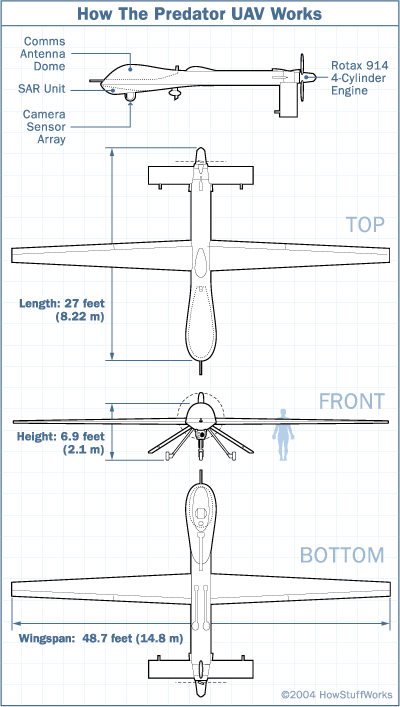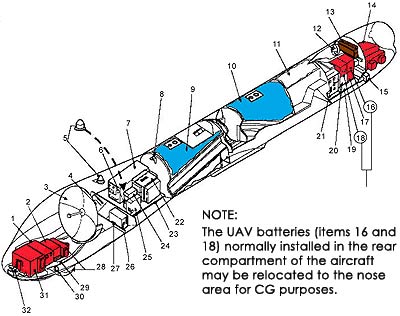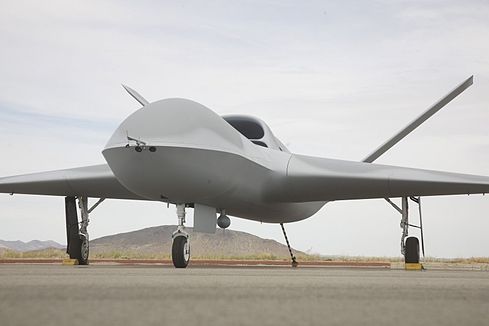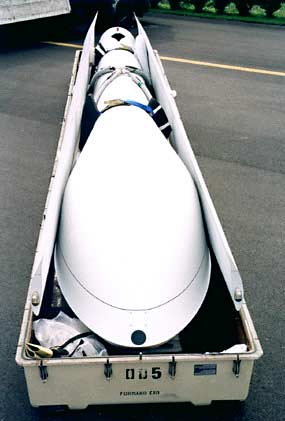|
The Predator UAV is a medium-altitude; long-range aircraft that operates much like any other small plane. These high-tech aircraft, controlled by a crew miles away from the dangers of combat, are capable of reconnaissance, combat and support roles in the hairiest of battles. In a worst-case scenario, if a Predator is lost in battle, military personal can simply "crack another one out of the box" and have it up in the air shortly -- and that's without the trauma of casualties or prisoners normally associated with an aircraft going down. A Rotax 914, four-cylinder, four-stroke, 101-horsepower engine, the same engine type commonly used on snowmobiles, turns the main drive shaft. The drive shaft rotates the Predator's two-blade, variable-pitch pusher propeller. The rear-mounted propeller provides both drive and lift. The remote pilot can alter the pitch of the blades to increase or decrease the altitude of the plane and reach speeds of up to 135 mph (120 kts). There is additional lift provided by the aircraft's 48.7-foot (14.8-meter) wingspan, allowing the Predator to reach altitudes of up to 25,000 feet (7,620 meters). The slender fuselage and inverted-V tails help the aircraft with stability, and a single rudder housed beneath the propeller steers the craft. The fuselage of the Predator is a mixture of carbon and quartz fibers blended in a composite with Kevlar. Underneath the fuselage, the airframe is supported by a Nomex, foam and wood laminate that is pressed together in layers. Between each layer of laminate, a sturdy fabric is sandwiched in to provide insulation to internal components. The rib work of the structure is built from a carbon/glass fiber tape and aluminum. The sensor housing and wheels are also aluminum. The edges of the wings are titanium and are dotted with microscopic weeping holes that allow an ethylene glycol solution to seep out of internal reservoirs and breakdown ice that forms on the wings during flight. The Predator UAV uses run-of-the-mill mechanical systems. A 3-kilowatt starter/alternator supplies the craft's electronics with power; this is supplemented with auxiliary battery power. Forward and aft fuel tanks house rubberized fuel bladders that are easy to fill through gas caps located at the top of the fuselage. An operator starts the engine by attaching the umbilical cord of a Starter/Ground Power Cart to the aircraft's starter-control connector, located in the ground panel on the outside of the plane. An operator stops the engine by hitting a kill switch just behind one of the wings on the side of the plane. For the Engine
As an aircraft, the Predator UAV is little more than a super-fancy remote-controlled plane. But this simple design lends itself well to the Predator's intended functions. Below you can see the placement of components:
The RQ-1 is the reconnaissance version of the Predator UAV. The letter 'R' is the U.S. Defense Department signature for an aircraft designated for reconnaissance. 'Q' is a designation for unmanned or automated weapons or vehicles. The simple and lightweight design of the Predator's fuselage allows it to carry a payload of up to 450 pounds (204 kg) in addition to the weight of its 100- gallon (378.5-liter) fuel tank. This large fuel tank and the nice gas mileage afforded by the Predator's light weight are great assets for a reconnaissance aircraft. The Predator can stay in the air monitoring enemy positions for up to 24 hours fully loaded. The RQ-1 uses some of the most sophisticated monitoring equipment available today:
Every camera in the plane's forward bank can produce full-motion video and still-frame radar images. The RQ-1 can give real-time imagery of the enemy position to a command post well before the first troops or vehicles arrive. This kind of information allows field commanders to make quick and informed decisions about troop deployment, movements and enemy capabilities. Of course, the greatest advantage of using the Predator is that it has all the advantages of a traditional reconnaissance sortie without ever exposing the pilot to a hostile environment. The only thing better than having a robotic airplane assist forces in making decisions about how to fight a battle is to have a robotic airplane actually fight the battle for you. That is where the Predator UAV MQ-1 Hunter/Killer comes into play. Replacing the camera array with the Multispectral Targeting System (MTS) and loading the Predator with two Hellfire missiles transforms this battlefield spotter into a deadly automated combatant. The 'M' in MQ-1 is the Defense Department designation for multipurpose aircraft; by adding the MTS and Hellfire missiles to the Predator, it truly becomes a multifunctional battle aircraft. The MTS includes the AGM-114 Hellfire missile targeting system, electro-optical infrared system, laser designator, and laser illuminator. All of these components give the Predator and its operators multiple ways to acquire a target in any combat environment. The Predator fires a laser or infrared beam from the MTS ball located near the nose of the plane. This laser can be used in two ways:
A fully operational system consists of four Predators (with sensors), a ground control station (GCS) that houses the pilots and sensor operators, and a Predator primary satellite-link communication suite. On the ground, there are the techs and support personnel normally associated with aircraft. The whole show takes about 82 personnel to run successfully. This fully integrated team is capable of using the four aircraft for 24-hour surveillance within a 400-nautical-mile radius of the ground control station. The Predator can run autonomously, executing simple missions such as reconnaissance on a program, or it can run under the control of a crew. The crew of a single Predator UAV consists of one pilot and two sensor operators. The pilot drives the aircraft using a standard flight stick and associated controls that transmit commands over a C-Band line-of-sight data link. When operations are beyond the range of the C-Band, a Ku-Band satellite link is used to relay commands and responses between a satellite and the aircraft. Onboard, the aircraft receives orders via an L-3 Com satellite data link system. The pilots and crews use the images and radar received from the aircraft to make decisions about controlling the plane. One of the greatest things about the Predator system is that the whole thing is fully transportable. The aircraft breaks down into six pieces that are transported in a huge crate called the coffin. The coffin contains:
Source : howstuffworks.com (Including pictures )
Leave a Reply. |
AuthorPalash Choudhari Archives
June 2021
Categories
All
|





 RSS Feed
RSS Feed
